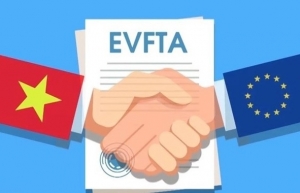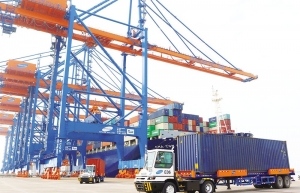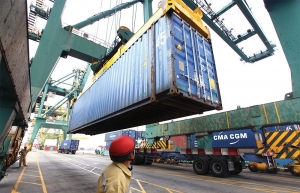Fulfilling the roadmap for a fruitful EU trade future
How do you assess bilateral trade now it has been two years since the EU-Vietnam Free Trade Agreement (EVFTA) took effect?
 |
| Bernd Lange, chairman of the European Parliament’s Committee on International Trade |
Two-way trade turnover is developing well. There has been an increase of 17 per cent in trade, with a slight advantage for Vietnam. So it’s not completely balanced but Vietnam is a developing country and there should be some advantages for it.
Of course, there were problems at the beginning for some specific goods. We have a clear commitment to the trade agreement ratifying some ideas of the conventions of the International Labor Organization (ILO).
We have also discussed how to improve and speed up the process. That is normal when such a comprehensive agreement has to be implemented and it’s working great. I know this from my constituency of Hamburg, a big player in Germany, where trade with Vietnam is increasing, and a lot of companies are now looking to the country for opportunities.
Can you share your view of how Vietnam has implemented its EVFTA commitments, particularly in the labour environment?
In all our trade agreements, we have some quite complex chapters on sustainability. This leads to some obligations on both sides, it’s not just a one-way ticket. And one element is the fulfilment of fundamental labour rights and the eight core ILO conventions – not only the ratification but also proper implementation.
I personally negotiated with the Vietnamese government for ratification of the EVFTA and a roadmap for its fulfilment. In principle, this roadmap is for the proper implementation of costs based on one situation. The deadlines are very precise, but this is normal. There is no question that the government is going in the right direction. There’s a lot of consultation with different stakeholders, and I expect that the last steps of the roadmap will be fulfilled next year.
It’s a matter of principle that trade benefits should also reach people on the ground. And there are several fundamental possibilities for a fair share of the benefits to reach out to everyone. It is both a question of collective bargaining and collective organisation to move ahead, so independent workers’ organisations are crucial in all our trade agreements.
I have had a lot of discussions on this with several countries. At the end of the day, if you want real support for ambitious trade agreements, you have to guarantee that the benefit of trade goes to the people.
The EVFTA has a section on leather and shoe production. How should companies in this sector prepare to take full advantage of the deal?
In my understanding, those industries are doing quite well. I have seen no real problem with the footwear industry. I just talked with a big company producing footwear in Vietnam a few days ago.
Of course, at the moment, the footwear industry is mainly based on foreign direct investment. But I see a lot of perspectives for domestic producers in the European market. In this big market, creative ideas are well received. However, we have to carefully respect the auditing rules and ensure that there is real added value for Vietnam. There are a lot of possibilities, and innovation is the driving force.
How will you contribute to lifting the yellow card warning from the European Commission on Vietnam’s fishing industry, and how big is the risk of Vietnam getting a red card?
I know that the fishing sector is really important for Vietnam. But overfishing and illegal fishing are also serious problems globally so we have to establish measurements for fishing. I know there is a lot of emphasis in Vietnam on fulfilling its obligations to the sustainable fishing segment.
Yes, sometimes it is complicated to convince fishermen that some electronic devices are necessary. I’m from the north of Germany, and some fishermen there also do not understand why it is necessary for a fluid system but, in principle, this can be solved. What I’ve heard so far is that Vietnam is going in the right direction for lifting the yellow card and not in the direction of getting a red card.
What other advice can be offered to Vietnam to take advantage of the EVFTA?
I think I’m unable to give advice because Vietnam is already doing quite well. Inflation is quite low in Vietnam and GDP is expected to increase around 7 per cent this year. That’s a figure some Europeans can only dream of. We have high inflation and quite a low growth rate. So, at the moment, the economic recovery in Vietnam is going great. Also, as I mentioned, the trade imbalance favours Vietnam.
Sometimes, of course, European exporters like to see more balance. We have strong exports in electronics to the EU, and in textiles, footwear, and in furniture. Because we also discussed illegal logging, Vietnam has also ratified a volunteer agreement on sustainable forest management.
This is also a big difference from other developing countries. In many developing countries, we have an expert structure based on raw materials, not products that have added value. This is the right way to do it, to be strong and a little more independent of other developing countries.
 | Room for agro-exports to grow through EVFTA deal While the export turnover of agro-products has taken off since 2020’s arrival of the EU-Vietnam Free Trade Agreement, ample room still remains neglected due to failure to meet the demand for quality. |
 | Evidence adds up for quality advantages within EVFTA Just two years in entry into force, the EU-Vietnam Free Trade Agreement (EVFTA) has brought large benefits to both the Southeast Asian market and the bloc of nearly 450 million people. |
 | EU keen to cement obligations in EVFTA Vietnam and the EU are increasing trade and investment ties backed by a bilateral free trade agreement, with the EU committing to assist in deployment of the deal despite current geopolitical tensions. |
What the stars mean:
★ Poor ★ ★ Promising ★★★ Good ★★★★ Very good ★★★★★ Exceptional
 Tag:
Tag:
Related Contents
Latest News
More News
- Main drivers for Vietnam’s digital economy future (December 03, 2025 | 11:35)
- Pivotal stage of growth paves way for rise in M&As (December 03, 2025 | 10:00)
- Positive projections for M&A interest from Thailand (December 03, 2025 | 09:40)
- Manifesting the first line of defence in cybersecurity (December 03, 2025 | 09:00)
- The transformational role AI can play in accounting arena (December 03, 2025 | 08:00)
- Unlocking 5G-AI potential in Singapore (December 03, 2025 | 08:00)
- Data-driven strategies vital for a fast-evolving nation (December 02, 2025 | 09:41)
- Policy to practice: how Vietnam can lead the region (November 26, 2025 | 16:03)
- Mobilising private capital at scale vital for climate battle (November 26, 2025 | 15:36)
- VILAF and Yoon & Yang launch Vietnam - Korea Practice Unit (November 26, 2025 | 15:16)























 Mobile Version
Mobile Version